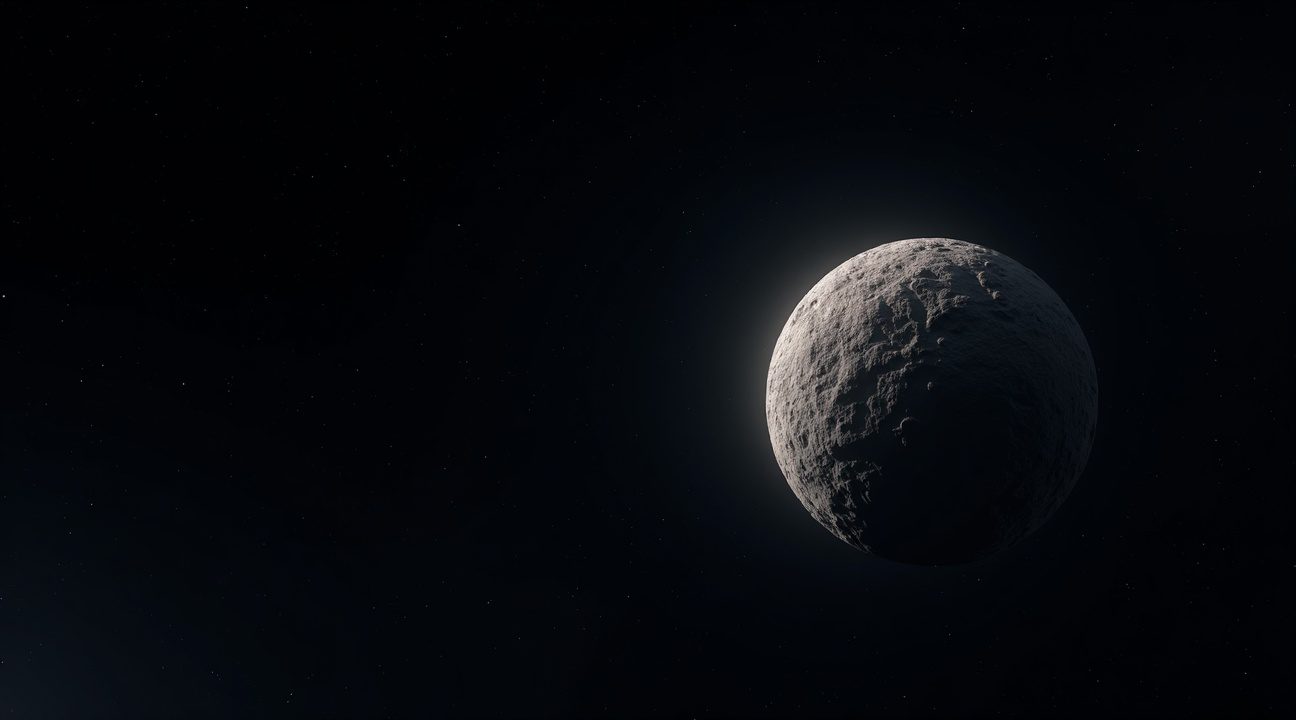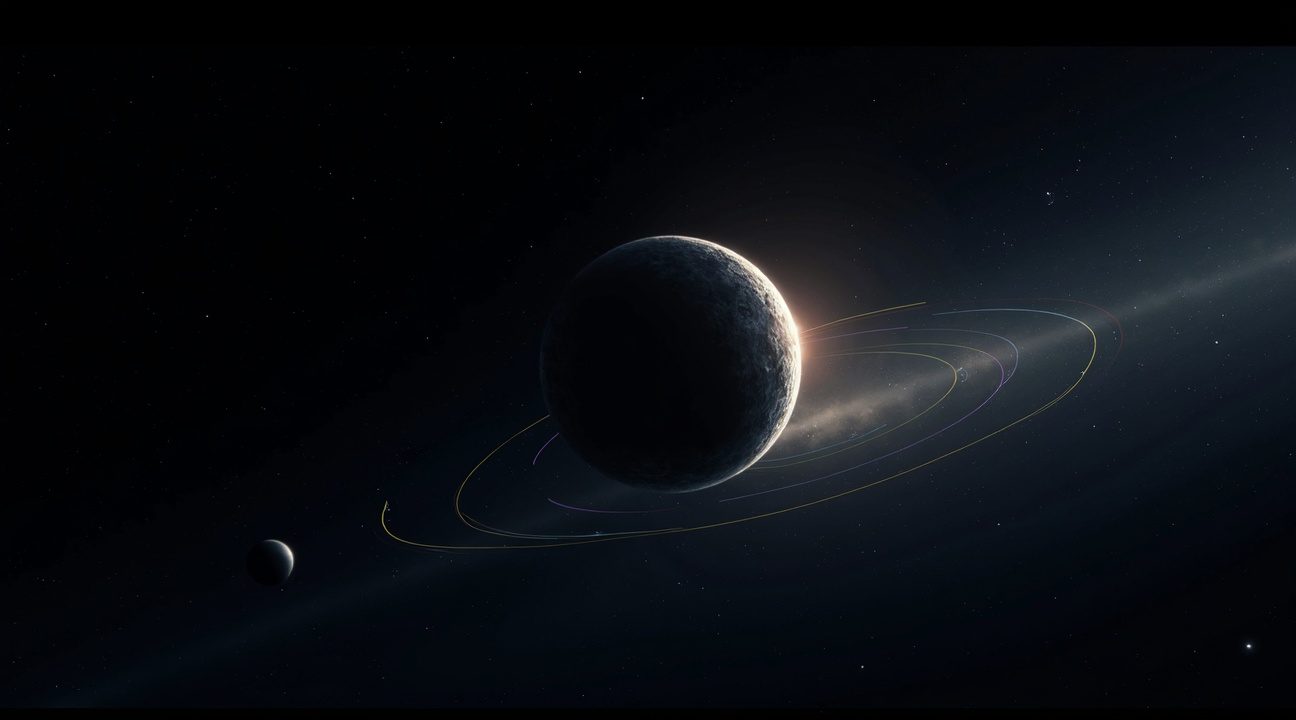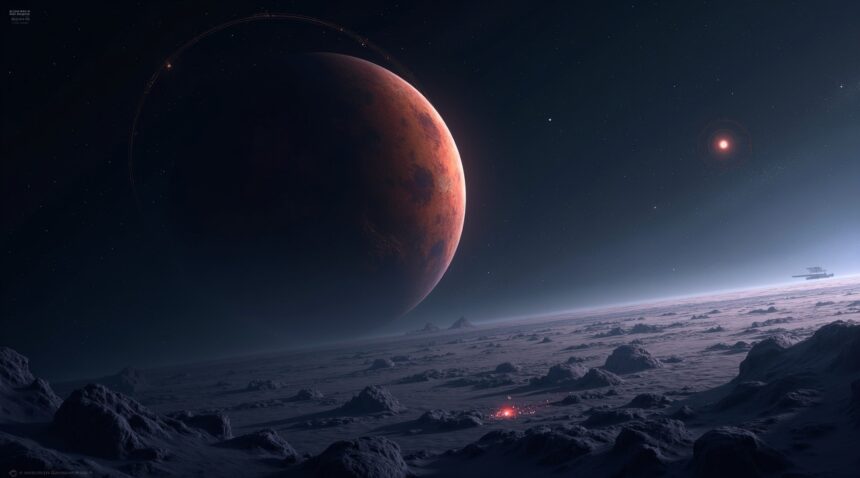Ammonite, officially designated 2023 KQ14, represents a groundbreaking discovery as the fourth confirmed sednoid—a rare class of distant objects with extremely elongated orbits beyond Neptune’s influence.
This newly identified dwarf planet occupies a crucial and previously unfilled gap among other known sednoids. Its presence challenges conventional models of outer solar system formation and may significantly impact the ongoing debate over the theoretical Planet Nine, long proposed by astronomers as influencing distant trans-Neptunian object orbits.
Key Takeaways
- Ammonite is the fourth confirmed sednoid, placing it in an exclusive category of solar system objects known for their elongated orbits that remain well beyond the sun’s dominant gravitational influence.
- The discovery was enabled by 19 years of observational data gathered through the FOSSIL survey, showcasing the power of archival telescope data in uncovering celestial bodies previously hidden in plain sight.
- Orbital data diverges from Planet Nine predictions, decreasing the statistical likelihood of this hypothetical planet’s existence to approximately 40%.
- Ammonite has exhibited orbital stability for an estimated 4.5 billion years, offering researchers a pristine record of the conditions and materials that existed during the early formation of the solar system.
- Gravitational perturbation evidence indicates a trajectory shift likely induced about 4.2 billion years ago, suggesting a dynamic and complex history for this unusual object.
For more information, you can read further details from the official Nature publication describing the discovery of Ammonite.
A Fourth Sednoid Challenges Everything We Know About the Outer Solar System
I discovered that Ammonite represents a significant breakthrough in our understanding of the most distant reaches of our solar system. With its official designation 2023 KQ14, this newly confirmed dwarf planet joins an exclusive group as only the fourth known sednoid—those enigmatic trans-Neptunian objects that dance in extremely elongated, high-perihelion orbits far beyond Neptune’s influence.
The discovery places Ammonite alongside its three predecessors: Sedna, 2012 VP113, and Leleākūhonua. However, this latest addition to the sednoid family brings with it a fascinating puzzle that’s forcing astronomers to reconsider their theories about the outer solar system’s architecture. What makes Ammonite particularly intriguing is its orbital position within a previously unpopulated ‘gap’ among other sednoids—a region astronomers didn’t expect to find such an object.
Orbital Characteristics That Defy Expectations
Ammonite’s most striking feature lies in its orbital parameters, which set it apart from its sednoid siblings. While all sednoids share the characteristic of extremely elongated orbits that keep them far from the sun’s gravitational dominance, Ammonite’s perihelion falls within a zone that models suggested should remain empty. This orbital placement challenges existing frameworks used to explain how these distant objects formed and evolved over billions of years.
The discovery becomes even more significant when considering how robots amazingly escape conventional detection methods in space exploration. Unlike its fellow sednoids, Ammonite’s current orbital path doesn’t align with the clustering patterns that would be expected if a massive, unseen planet—dubbed ‘Planet Nine’—were shepherding these objects through gravitational influence. This deviation from predicted behavior suggests that our understanding of the forces shaping the outer solar system may be incomplete.
Implications for Planet Nine Theory
The Planet Nine hypothesis has gained considerable attention among astronomers as a potential explanation for the unusual orbital clustering observed among many trans-Neptunian objects. According to this theory, a planet roughly five to ten times Earth’s mass exists in the far reaches of our solar system, its gravitational pull organizing distant objects into predictable patterns. However, Ammonite’s orbital characteristics don’t fit this model, presenting a significant challenge to the hypothesis.
This discrepancy doesn’t necessarily disprove Planet Nine’s existence, but it does complicate the picture considerably. Ammonite’s position suggests that either the proposed planet’s influence isn’t as straightforward as initially thought, or additional factors are at play in shaping these distant orbits. Some researchers propose that cold fusion breakthroughs in stellar research might provide new insights into how gravitational interactions work at such vast distances.
The implications extend beyond theoretical models. Ammonite’s discovery demonstrates that the outer solar system contains more diversity than previously recognized, with objects occupying orbital niches that challenge our predictive capabilities. Each new sednoid discovery provides crucial data points for understanding how the solar system formed and evolved, particularly during its chaotic early years when gravitational interactions were reshaping planetary orbits.
Furthermore, the gap-filling nature of Ammonite’s orbit raises questions about how many more undiscovered objects might exist in supposedly empty regions of space. Advanced survey telescopes continue scanning the sky for these elusive objects, and each discovery like Ammonite helps refine our search strategies and theoretical frameworks. The ongoing hunt for additional sednoids promises to either strengthen or further challenge our current understanding of the solar system’s most distant frontier.

How Advanced Telescopes Uncovered This Distant World Using 19 Years of Data
The discovery of Ammonite represents a remarkable achievement in modern observational astronomy, showcasing how cutting-edge telescope technology combined with decades of archival data can reveal hidden worlds in our solar system’s outer reaches. The breakthrough emerged from the FOSSIL (Formation of the Outer Solar System: An Icy Legacy) survey, a comprehensive project dedicated to mapping distant celestial bodies and understanding their evolutionary histories.
In March 2023, astronomers first detected Ammonite using the Subaru Telescope’s sophisticated HyperSuprimeCam during routine FOSSIL survey observations. This initial detection marked the beginning of an intensive verification process that would ultimately confirm the existence of this distant world. The HyperSuprimeCam’s exceptional sensitivity and wide field of view made it particularly well-suited for detecting faint objects in the outer solar system, where Ammonite resides far beyond Pluto’s orbit.
Confirming the Discovery Through Multi-Telescope Collaboration
Following the initial detection, researchers turned to the Canada-France-Hawaii Telescope for crucial follow-up observations to confirm Ammonite’s existence and refine its orbital characteristics. This collaborative approach demonstrates how modern astronomical discoveries often require multiple observational facilities working together to validate findings. The combination of these two powerful telescopes provided the necessary data quality and observational baseline to establish Ammonite as a legitimate solar system object rather than a distant star or galaxy.
What makes this discovery particularly impressive is the retroactive tracking achieved through systematic archival image searches spanning 19 years. Astronomers meticulously combed through decades of telescope data, identifying Ammonite’s presence in images that had been captured years before anyone knew to look for it. This process of linking current observations with historical data points allows scientists to reconstruct the object’s orbital path with remarkable precision, much like how advanced robotics can adapt and navigate complex environments.
The FOSSIL project itself represents a significant advancement in our approach to studying the outer solar system. By systematically measuring sub-populations of distant objects and tracking their evolutionary histories, this survey enhances our understanding of how the solar system formed and evolved over billions of years. The project’s methodology combines traditional observational techniques with modern astroinformatics approaches, processing vast amounts of data to identify patterns and objects that might otherwise remain hidden.
Advanced optical telescopes like the Subaru Telescope have revolutionized our ability to detect faint, distant objects. The HyperSuprimeCam, in particular, represents the pinnacle of astronomical imaging technology, capable of capturing incredibly detailed images across wide swaths of sky. This capability proves essential for surveys like FOSSIL, which must cover large areas of space while maintaining the sensitivity needed to detect objects as distant and faint as Ammonite.
The systematic archival approach used in this discovery highlights how modern astronomy increasingly relies on data mining and computational analysis. Rather than simply looking forward for new discoveries, astronomers now routinely examine years or decades of existing observations, applying new analysis techniques to extract previously unrecognized signals. This approach has led to numerous discoveries across various fields, from ancient ecosystems to breakthrough technologies.
The 19-year data span used to track Ammonite’s movement provides an unusually long observational baseline for determining its orbital characteristics. This extended timeline allows astronomers to calculate the object’s trajectory with high confidence, predicting where it will be located in future observations and establishing its membership in specific dynamical populations within the outer solar system.
Sky surveys like FOSSIL represent the future of astronomical discovery, systematically cataloging objects across vast regions of space rather than focusing on individual targets. These surveys generate enormous datasets that continue yielding discoveries long after the initial observations, as demonstrated by Ammonite’s detection in archival data from previous years. Such comprehensive approaches ensure that future astronomers will have rich datasets to mine for additional discoveries, potentially revealing many more distant worlds lurking in our solar system’s outer regions.
The Mysterious Object That Doesn’t Fit Planet Nine Predictions
Ammonite’s discovery has thrown a significant wrench into one of astronomy’s most compelling mysteries. For years, scientists have proposed that a massive, undiscovered planet lurks in the outer reaches of our solar system, influencing the orbits of distant objects through its gravitational pull. This hypothetical world, known as Planet Nine, was theorized to explain why certain extreme trans-Neptunian objects cluster together in unusual orbital patterns.
However, Ammonite refuses to follow the script. Statistical analyses now suggest only a 40% chance remains for Planet Nine’s existence, and this newly discovered world presents orbital characteristics that directly contradict the predicted influence of such a massive planet. The object’s trajectory doesn’t align with the clustering patterns that initially sparked the Planet Nine hypothesis, forcing astronomers to reconsider their assumptions about what shapes the outer solar system.
Alternative Forces Shaping the Cosmic Edge
Instead of supporting the giant planet theory, Ammonite’s behavior points toward different mechanisms that could have sculpted the distant solar system. Ancient stellar encounters likely played a crucial role in determining these orbital patterns, as passing stars could have gravitationally nudged objects into their current paths millions of years ago. These cosmic interactions would have occurred when our solar system was young and still embedded within a stellar nursery.
Internal dynamical instabilities also offer compelling explanations for the observed orbital architecture. During the solar system’s chaotic early period, gravitational interactions between the giant planets could have scattered countless objects outward, creating the complex distribution patterns we observe today. These processes would naturally produce some clustering without requiring an additional massive planet.
The implications extend far beyond Ammonite itself. Perturbation studies of outer solar system objects now suggest that multiple factors contributed to their current orbits, rather than a single dominant influence. This complexity makes it increasingly difficult to support the clustering hypothesis that originally motivated the Planet Nine search. As more distant objects like Ammonite are discovered, they continue to reveal that our solar system’s outer edge harbors surprises that challenge our most fundamental theories about planetary formation and evolution.
A World Frozen in Time with Secrets from 4.5 Billion Years Ago
Ammonite represents a fascinating glimpse into the primordial solar system, offering scientists an unprecedented opportunity to study conditions that existed during our cosmic neighborhood’s formation. This distant world measures between 220 to 380 kilometers in diameter, placing it in a size category similar to other confirmed sednoids while remaining considerably smaller than Pluto.
Orbital Characteristics That Define Ancient Stability
The object’s highly elliptical orbit stretches across vast distances, with its perihelion positioned between 50–75 astronomical units from the Sun and its aphelion reaching approximately 252 AU. These measurements place Ammonite in a unique position compared to other distant worlds. Pluto maintains a much closer orbit with a perihelion of 29.7 AU and aphelion of 49.3 AU, while Sedna ventures much farther with its perihelion at 76 AU and aphelion at 900 AU.
Computer simulations reveal that Ammonite’s orbital path has remained remarkably stable for at least 4.5 billion years. This extraordinary stability means the object has likely preserved materials and conditions from the solar system’s earliest epochs, essentially functioning as a cosmic time capsule. Such long-term orbital evolution provides researchers with invaluable data about gravitational influences and planetary migration patterns that shaped our solar system’s architecture.
Scientific Implications of Primordial Preservation
The discovery’s significance extends beyond mere cataloging of distant objects. Ammonite’s position and orbital characteristics suggest it formed in the outer regions of the primordial solar disk, where temperatures remained extremely cold and chemical processes proceeded slowly. This environment would have allowed pristine preservation of original materials, including potentially organic compounds and volatile substances that existed during the solar system’s birth.
Recent breakthroughs in detection technology, similar to advances seen in other fields like cold fusion research, have enabled astronomers to identify such distant objects with greater precision. The stable nature of Ammonite’s orbit indicates it has avoided significant gravitational perturbations from the giant planets, making it an ideal candidate for studying unaltered primordial materials.
Scientists believe that examining objects like Ammonite could provide crucial insights into the composition of the early solar nebula, planetary formation processes, and the distribution of elements during our system’s formative years. The object’s remote location has shielded it from solar radiation and collisional modification, preserving a record of conditions that existed when the first planets were coalescing from cosmic dust and gas.

The Dramatic Event That Changed Ammonite’s Path Through Space
I find it fascinating that Ammonite’s current orbital position tells a story of cosmic violence from the early solar system. Around 4.2 billion years ago, this distant world followed a path similar to other sednoids—those enigmatic objects that dance at the outer edges of our solar system. Something dramatic happened that forever changed Ammonite’s destiny.
Evidence suggests a powerful gravitational perturbation yanked Ammonite from its original trajectory, sending it careening into what was previously an empty region of space. This ancient disruption explains why astronomers discovered Ammonite occupying a unique orbital gap among sednoids, standing alone where no similar objects had been found before. The event was so significant that it fundamentally altered the object’s relationship with the rest of the solar system.
Chaotic Origins in the Early Solar System
The timing of this dramatic orbital shift coincides perfectly with one of the most turbulent periods in solar system history. During this era, stellar encounters were commonplace as our young sun still resided within its birth cluster. Scientists have documented how breakthrough research in stellar dynamics reveals that passing stars could exert tremendous gravitational influence on distant objects like Ammonite.
Several scenarios could explain Ammonite’s orbital evolution during this chaotic period:
- A close stellar flyby that gravitationally scattered multiple objects from their original paths
- Planetary migration events that destabilized the outer solar system’s architecture
- Interactions with a massive, undiscovered planet that has since been ejected or moved to a different orbit
- Collision cascades that fundamentally reshaped the distribution of small bodies in the outer solar system
The gravitational fingerprints of this ancient event remain visible today in Ammonite’s highly eccentric orbit. Unlike other sednoids that maintain more predictable paths, Ammonite’s trajectory bears the scars of its violent past. This orbital signature provides crucial evidence for understanding how external forces shaped our solar system’s current configuration.
Recent studies of early solar system dynamics suggest that stellar encounters were particularly frequent during the first few hundred million years after the sun’s formation. These cosmic close calls didn’t just affect distant objects like Ammonite—they likely influenced the architecture of the entire outer solar system. The discovery of ancient structures in various contexts reminds us how past events leave lasting impressions on present-day systems.
Understanding Ammonite’s orbital evolution helps astronomers piece together the broader puzzle of solar system formation. The object serves as a fossil record of conditions that existed billions of years ago, preserving evidence of gravitational chaos that has long since subsided. Its isolated position among the sednoids makes it particularly valuable for studying how external perturbations can dramatically alter celestial mechanics.
The fact that Ammonite survived such a dramatic gravitational encounter while maintaining its structural integrity speaks to the resilience of these distant worlds. Many objects subjected to similar forces would have been completely ejected from the solar system or shattered into fragments. Ammonite’s persistence in its altered orbit provides a unique opportunity to study both the object itself and the ancient forces that shaped its current path through space.
This ancient disruption also raises intriguing questions about what other hidden influences may have shaped our solar system’s evolution. As astronomers continue mapping the outer reaches of our cosmic neighborhood, objects like Ammonite serve as crucial waypoints for understanding the dynamic forces that sculpted the architecture we observe today.

Where Ammonite Fits in the Growing Census of Distant Worlds
Ammonite’s discovery arrives at a fascinating time when astronomers are rapidly expanding their catalog of distant celestial bodies. I find it remarkable that as of April 2025, researchers have identified an impressive array of objects beyond Neptune, each representing a piece of our solar system’s complex outer frontier.
The current census reveals a structured hierarchy of confidence levels that astronomers use to classify these remote worlds. At the highest tier, I observe 10 objects that scientists consider nearly certain dwarf planets, followed by 27 highly likely candidates. The classification system extends further to include:
- 68 likely dwarf planets
- 130 probable candidates
- 741 possible dwarf planets scattered throughout the outer reaches
Ammonite’s Significance Among Recent Discoveries
Ammonite stands alongside 2017 OF201 as one of the most recently announced distant dwarf planet candidates, marking a significant milestone in trans-Neptunian object research. These formal announcements don’t happen frequently, making Ammonite’s inclusion particularly noteworthy for several key reasons:
- The discovery demonstrates improved detection capabilities that allow astronomers to identify increasingly distant objects
- Ammonite’s characteristics provide fresh data for understanding the formation and evolution of the outer solar system
- The object’s orbit and composition offer insights into the dynamic processes that shaped the Kuiper Belt and scattered disk regions
- Its discovery helps refine models of planetary migration and the early solar system’s gravitational interactions
I consider Ammonite a cornerstone discovery because it represents more than just another distant rock. The object contributes valuable data to our understanding of how ancient formations in space evolved over billions of years. Each new trans-Neptunian object discovery helps astronomers piece together the solar system’s history, much like archaeologists studying artifacts from different time periods.
The diverse population of objects beyond Neptune’s influence continues to surprise researchers with its complexity. From the relatively stable Kuiper Belt to the chaotic scattered disk, these regions harbor worlds that experienced vastly different evolutionary paths. Ammonite’s characteristics and orbital dynamics provide crucial information about the gravitational forces that sculpted these distant realms.
This growing census demonstrates that our solar system’s outer boundaries contain far more complexity than previously imagined. While breakthrough discoveries in various scientific fields capture headlines, the methodical cataloging of distant worlds like Ammonite represents equally important progress in understanding our cosmic neighborhood’s true extent and diversity.

Sources:
IFLScience – “Something Extraordinary Occurred: A New 380-Kilometer World Has Been Found In Our Solar System”
Universe Today – “A Rare Object Found Deep in the Kuiper Belt”
ENTECH Online – “Solar System Exploration: The Mystery of Ammonite”
Smithsonian Magazine – “Astronomers Discover ‘Ammonite,’ a Mysterious Distant Object That Could Shed Light on Our Solar System’s History”
Live Science – “Astronomers Discover New Dwarf Planet ‘Ammonite'”
YouTube, Anton Petrov – “Strange Object Called Ammonite Invalidates Planet Nine Hypothesis”
NextBigFuture – “New Dwarf Planets Beyond Neptune in 2025”


